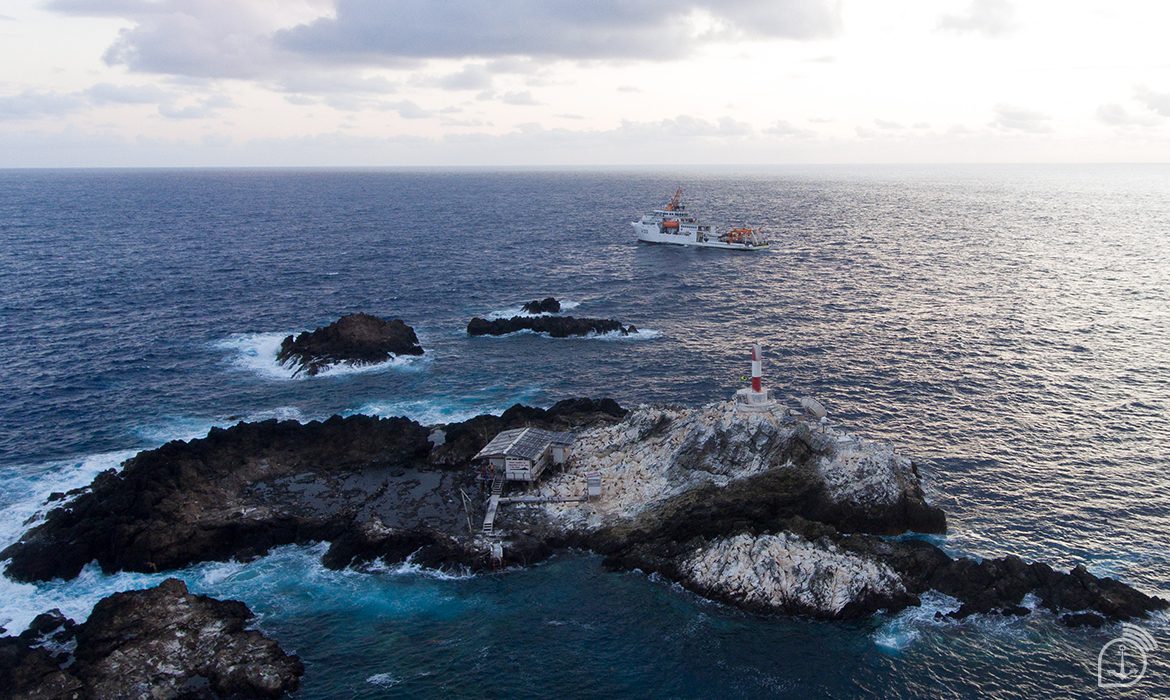Ships and scientific stations support research in the Blue Amazon
By First-Lieutenant (RM2-T) Luciana Santos de Almeida – Brasília, DF
From today on November 16th, National Blue Amazon Day, the Marine News Agency will publish a series of reports on this maritime area, the main means of transportation for the country’s foreign trade, which besides housing a great diversity of natural resources (such as fish and marine biodiversity) is an important reserve of oil, gas and other mineral resources. The reports will cover the activities of the Blue Amazon under the focus of its four aspects: scientific, economic, environmental, and sovereignty. This is the first of them, which highlights the scientific research carried out in this environment.
Law No. 13,187 of 2015 established the National Blue Amazon Day, celebrated annually throughout the national territory. The date aims to make the population aware of the importance of the Blue Amazon, an ocean area connected to the Brazilian territory with about 5.7 million km², larger than the size of the Green Amazon and equivalent in terms of biodiversity and resources.
On the scientific side, the Brazilian Navy (MB) reports that, in 2022 alone, 142 researchers have already embarked on its research vessels, including those operating in Antarctica. Many of these expeditions take place on oceanic islands, including the Archipelago of São Pedro and São Paulo (ASPSP) and Trindade Island, where the Navy has appropriate structures to support research and provide adequate accommodation for researchers. The access to these remote places is also coordinated by the MB, which provides training for scientists to enter different environments, as is the case of research in the Antarctic Continent, whose support base is the Antarctic Station Comandante Ferraz.
The Vice-Rector of the Federal University of Pernambuco, Professor Moacyr Cunha de Araújo Filho, states that the embarkation to carry out scientific research is fundamental for Oceanography undergraduates and related areas. “To work in marine sciences, the embarkations are moments of much learning. I would say that it is fundamental for the researcher, the one who is going to pursue an academic career, to have embarking experiences, to feel all the difficulty, concern, and learning of collecting data on the spot,” said the researcher who has participated in expeditions on Navy research ships since the 1990s.
Professor Doctor Moacyr compares the ocean to a large open-air laboratory. “It’s like a laboratory in which we still don’t know all the areas, all the sections. And one of them would be the ocean floor, the deepest part of the ocean. I think we have a great opportunity to advance in this sense, and use the ocean as a real platform for study, for teaching, for training, and also as a great storehouse of natural reserves that are being very little explored. And doing this with sustainability is fundamental,” he concluded.
National interests in the Blue Amazon
For Sea and War Captain Ana Cláudia de Paula, oceanographer and in charge of the Living Resources Division of the Secretariat of the Interministerial Commission for the Resources of the Sea (SECIRM), the Navy’s involvement is essential for the development of research in the oceanic and marine areas of Brazil. “Due to the extension of the Blue Amazon, its relevance to the country and to the global climate balance, a diversity of scientific inquiries emerges, in different areas of knowledge. In this way, the MB joins the national effort through partnerships with scientific institutions and those that promote research. Thus, having researchers on board its ships consolidates one of the Navy’s contributions in strengthening Brazilian science in the international scenario”, he said.
The researches contribute to the expansion of knowledge and to the effective use of the marine environment in the interest of the MB, being fundamental to the employment and planning of naval operations, rescue and salvage. “These surveys are also important tools for the Blue Amazon Management System (SisGAAz), contributing to the establishment of the architecture and distribution of sensors on the Brazilian coast and oceanic islands,” explained Sea Captain Ana Cláudia.
The Interministerial Commission for the Resources of the Sea (CIRM) has three plans that are directly related to the Blue Amazon: the Survey Plan of the Brazilian Continental Shelf (LEPLAC); the National Coastal Management Plan (PNGC); and the Sectorial Plan for the Resources of the Sea (PSRM).
The LEPLAC aims to establish the outer limit of the Continental Shelf in order to determine the maritime area, beyond 200 nautical miles, in which Brazil will exercise its sovereignty rights for the exploration and exploitation of the natural resources of the seabed and subsoil.
The PNGC aims to promote the country’s coastal management as well as the sustainable use of coastal resources, through the integrated planning of the use of these resources. The planning is important because the Coastal Zone is home to a mosaic of ecosystems of high environmental relevance, whose diversity is marked by the transition between terrestrial and marine environments.
The PSRM has several programs and actions aimed at the conservation and sustainable exploitation of marine resources, conducted and coordinated by CIRM. Through the PSRM it is possible to carry out research activities, oceanographic monitoring and climate studies, as well as the exploration and conservation of its natural resources. Research is carried out on the islands of Trindade and Martin Vaz and on the São Pedro and São Paulo Archipelago, through the Scientific Research Program on Trindade Island (PROTRINDADE) and the São Pedro and São Paulo Archipelago Program (PROARQUIPELAGO).
*** Translated by the DEFCONPress FYI team ***
